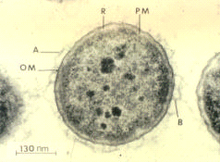| Aeromonas salmonicida | |
|---|---|

| |
| Scientific classification | |
| Domain: | Bacteria |
| Phylum: | Pseudomonadota |
| Class: | Gammaproteobacteria |
| Order: | Aeromonadales |
| Family: | Aeromonadaceae |
| Genus: | Aeromonas |
| Species: | A. salmonicida
|
| Binomial name | |
| Aeromonas salmonicida (Lehmann and Neumann 1896) Griffin et al. 1953
| |
| Synonyms | |
|
Bacillus salmonicida (Lehmann and Neumann 1896) Kruse 1896 Bacterium salmonicida Lehmann and Neumann 1896 Proteus salmonicida (Lehmann and Neumann 1896) Pribram 1933 | |
Aeromonas salmonicida is a pathogenic bacterium that severely impacts salmonid populations and other species. It was first discovered in a Bavarian brown trout hatchery by Emmerich and Weibel in 1894.[1] Aeromonas salmonicida's ability to infect a variety of hosts, multiply, and adapt, make it a prime virulent bacterium. A. salmonicida is an etiological agent for furunculosis, a disease that causes sepsis, haemorrhages, muscle lesions, inflammation of the lower intestine, spleen enlargement, and death in freshwater fish populations. It is found worldwide with the exception of South America.[1][2] The major route of contamination is poor water quality; however, it can also be associated stress factors such as overcrowding, high temperatures, and trauma. Spawning and smolting fish are prime victims of furunculosis due to their immunocompromised state of being.
- ^ a b "Furunculosis". Merck. Archived from the original on 30 July 2015. Retrieved 2011-06-11.
- ^ Charette, Steve J. (2021-05-04). "Microbe Profile: Aeromonas salmonicida: an opportunistic pathogen with multiple personalities". Microbiology. 167 (5). doi:10.1099/mic.0.001052. hdl:20.500.11794/106763. ISSN 1350-0872. PMID 33945463. S2CID 233740911.